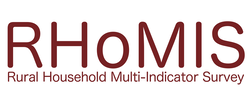|
Our RHoMIS work has led to a unique harmonised database of quantitative information on smallholder livelihoods in low and middle income countries (now containing interviews of more than 28,000 households in 31 countries). We are now in full force analysing these data to identify pathways towards food security, and underpin strategic studies trying to identify the drivers of diverse diets and possible trade offs between agricultural production intensification and key welfare indicators like gender equity. What is less known is that our RHoMIS research actually originated from work focusing on bringing together existing household survey data from a wide range of projects and using those data to identify common indicators of food security, and farm livelihood characteristics determining food security. In that work we developed a simple indicator of food security that we could quantify across all the household survey datasets. That indicator was also quantified using other datasets, for example the Worldbank’s Living Standards Measurement Studies – Integrated Survey on Agriculture (LSMS-ISA in short). See recent open access papers led by Jannike Wichern of Wageningen University on that work (bottom of article for reference). The information underpinning this potential food availability indicator actually forms the core of RHoMIS, so to speak, which then allows us to easily combine RHoMIS data together with the other databases we have developed, thereby allowing for even larger scale analyses than we would be able to do with just the RHoMIS data. For example, for sub Saharan Africa alone this harmonised database combining RHoMIS data with the other data has already surpassed 40,000 households. A paper in Global Change Biology led by Katharina Waha from CSIRO (reference at bottom of article) provides a first example of this analysis, focusing on the relationship between production diversification and food security. In a recent paper for the Independent Science and Partnership Council of the CGIAR (available here) we illustrate how we use these data to:
All of this work can be used to quantitatively evaluate progress we are making towards achieving several of the Sustainable Development Goals: in particular SDG 1 (no poverty), 2 (zero hunger), 5 (gender equity), 12 (responsible consumption and production) and 13 (climate action). This is an important priority for our work.
Our toolbox of data collection and analysis methods thereby generates locally relevant information that is used for setting baselines, monitoring progress and targeting interventions by our partners, while it allows us to build a large harmonised database that can be used for a wide range of strategic analyses, quantification of the progress towards achieving the SDGs in rural areas, and explorations of farmers’ futures. The combination of the Worldbank’s LSMS-ISA effort and sources like the DHS data, which normally give less detail (and often lower data quality), together with our targeted RHoMIS applications allow for better spatial representativeness. As stressed above, an essential element in our work is harmonisation of data collection and indicator quantification methods. The progress we made in our work and the representative power of our analyses were based on this harmonisation effort, while it also made data collection and monitoring and evaluation a much more straightforward process for our development partners. A key word in our RHoMIS work has also been ‘flexibility’. Harmonisation without the necessary flexibility to make tools and analyses fit-for-purpose would not lead to uptake of the methods by our partners. It is a delicate balance to strike (i.e. harmonisation versus flexibility) and not all of our potential partners agreed with the (tough) decisions we sometimes had to make to ensure that harmonised information was collected. As RHoMIS looks to the future, we continue to stress that harmonised approaches lead to powerful and easily re-usable ‘big’ data, and we hope that outputs like the ISPC position paper help in that endeavour. Select references:
0 Comments
Your comment will be posted after it is approved.
Leave a Reply. |
RHoMIS BlogThe RHoMIS blog is written by a community of practice. The COP is made up of RHoMIS users and creators from across the world. Here we share their stories of how RHoMIS is helping to record and analyse household data. Archives
May 2020
Categories
All
|



 RSS Feed
RSS Feed